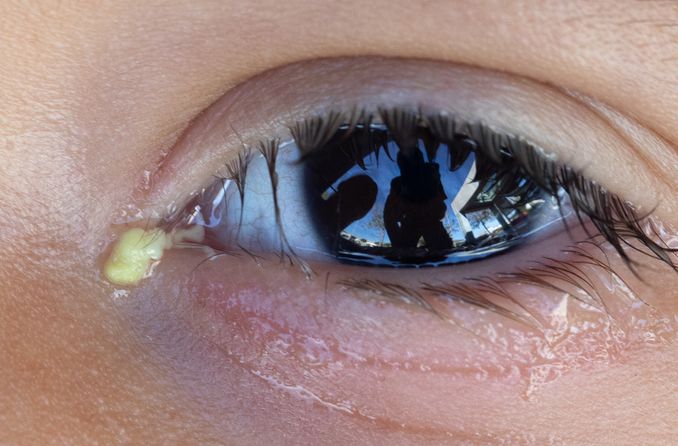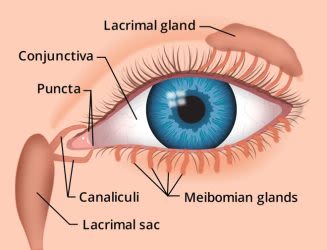Eye discharge: causes and treatment

Eye discharge, or "sleep" in your eyes, is a combination of mucus, oil, skin cells and other debris that accumulates in the corner of your eye while you sleep. It can be wet and sticky or dry and crusty, depending on how much of the liquid in the discharge has evaporated.
Sometimes called rheum, eye discharge has a protective function, removing waste products and potentially harmful debris from the tear film and the front surface of your eyes.
Your eyes produce mucus throughout the day, but a continuous thin film of tears bathes your eyes when you blink, flushing out the rheum before it hardens in your eyes.
When you're asleep — and not blinking — eye discharge collects and crusts in the corners of your eyes and sometimes along the lash line, hence the term "sleep in your eyes."
Some sleep in your eyes upon waking is normal, but excessive eye discharge, especially if it's green or yellow in color and accompanied by blurry vision, light sensitivity or eye pain, can indicate a serious eye infection or eye disease and should be promptly examined by your eye doctor.
[Click here to find an eye doctor now if you don't have one.]
Where does eye mucus come from?
Eye discharge primarily consists of thin, watery mucus produced by the conjunctiva (called mucin), and meibum — an oily substance secreted by the meibomian glands which helps keep your eyes lubricated between blinks.
When not washed away by tears, the accumulated debris, or "mattering," collects in the inner corner of the eye as well as along the lash line.
Causes of eye discharge
Sleep in your eyes usually isn't cause for alarm, but if you notice a difference in consistency, color and quantity of eye discharge, it could indicate an eye infection or disease.
Common eye conditions associated with abnormal eye discharge include:
Conjunctivitis. Eye discharge is a common symptom of conjunctivitis (pink eye), an inflammation of the thin membrane that lines the "white" of the eye (sclera) and the inner surface of the eyelids.
In addition to itchy, gritty, irritated and red eyes, conjunctivitis typically is accompanied by white, yellow or green eye mucus which can form a crust along the lash line while you sleep. In some cases, eyelid crusting can be so severe that it temporarily seals your eye shut.
There are three types of pink eye:
1. Viral conjunctivitis is highly contagious and is caused by a virus such as the common cold or herpes simplex virus. Eye discharge associated with viral pink eye typically is clear and watery, or it may include white or slightly yellow mucus.
2. Bacterial conjunctivitis, as the name indicates, is caused by a bacterial infection. It can be sight-threatening if not treated promptly. Eye discharge from bacterial conjunctivitis usually is thicker and more purulent (pus-like) than viral pink eye, and is commonly yellow, green or even gray in color. Often, the sticky mattering will cause your eyelids to feel completely glued shut upon waking in the morning.
3. Allergic conjunctivitis is triggered by allergens — pollen, dander, dust and other common irritants that cause eye allergies. It also can be caused by an allergic reaction to chemical pollutants, makeup, contact lens solutions, and eye drops. Eye discharge associated with allergic conjunctivitis typically is watery. Allergic conjunctivitis is not contagious and always affects both eyes.
Other eye infections. In addition to conjunctivitis, there are many eye infections that cause abnormal eye discharge. These include:
Fungal keratitis (a rare but serious inflammation of the cornea)
Acanthamoeba keratitis (a potentially blinding parasitic infection typically caused by poor contact lens hygiene or swimming while wearing contacts).
Discharge from an eye infection varies considerably — it could be clear and watery or thick, green and sticky — so make sure you see your eye doctor promptly for an accurate diagnosis and treatment.
Blepharitis. A chronic disorder of the eyelids, blepharitis describes either inflammation of the eyelash hair follicles or abnormal oil production from the meibomian glands at the inner edge of the eyelids.
Meibomian gland dysfunction. Also called MGD, this malfunctioning of oil glands in the eyelid can cause foamy eye discharge, eyelid crusting, as well as yellow or green eye pus, among other irritating and often painful symptoms.
Stye. A stye is a clogged meibomian gland at the base of the eyelid, typically caused by an infected eyelash follicle. Also called a hordeolum, it resembles a pimple on the eyelid margin and is commonly accompanied by redness, swollen eyelids and tenderness in the affected area. Yellow pus, eyelid crusting and discomfort while blinking also can occur.

The tear drainage system keeps the eye moist and protected.
Dry eyes. Insufficient tear production or dysfunction of the meibomian glands can lead to dry eye syndrome — an often chronic condition in which the surface of the eyes is not properly lubricated and becomes irritated and inflamed. Symptoms of dry eyes include red, bloodshot eyes, a burning sensation, blurry vision and a feeling something is "in" your eye (foreign body sensation). Sometimes, dry eyes also can cause a very watery eye discharge to occur.
Contact lenses. If you wear contact lenses, you may find more sleep in your eyes than normal. This can be due to a number of reasons, including a contact lens-related eye infection, contact lens discomfort resulting in dry and irritated eyes, as well as rubbing your eyes more while wearing contacts. If you experience an increase in eye discharge when wearing contacts, remove your lenses and see your eye doctor to rule out a potentially serious eye condition.
Eye injury. A foreign body in the eye (such as dirt, debris or a chemical substance) or an eye injury can cause your eyes to secrete a watery discharge as a natural protective response. If eye pus or blood in the eye (subconjunctival hemorrhage) occurs after an eye injury, see your eye doctor immediately for treatment. All eye injuries should be treated as a medical emergency.
Corneal ulcer. A corneal ulcer is a sight-threatening, abscess-like infection of the cornea, usually caused by trauma to the eye or an untreated eye infection. If not treated promptly, corneal ulcers can lead to complete vision loss. Eye pain, redness, swollen eyelids and thick eye discharge are characteristic of a corneal ulcer. Eye pus can be so severe that it clouds the cornea and impairs vision.
Dacryocystitis. When a tear duct is blocked, the lacrimal sac in the tear drainage system leading to the nose can become inflamed and infected, causing a tender and swollen bump to appear under the inner eyelid. In addition to pain and redness, common symptoms of dacryocystitis include watery eyes, a sticky eye discharge and blurred vision.
Eye discharge treatment
A small amount of eye discharge is harmless, but if you notice changes in the color, frequency, consistency and amount, consult your eye doctor.
If an eye infection is the cause of eye mucus, your eye care practitioner may prescribe antibiotic or antiviral eye drops and ointments. If eye allergies are making your eyes watery and irritated, over-the-counter antihistamine eye drops and decongestants may relieve symptoms.
Warm compresses placed over your eyes may help relieve symptoms of itching and general eye discomfort, as well as help remove eye discharge.
If your eyelids are stuck together, the best way to "unglue" your lids is to wet a washcloth in hot water and place it over your eyes for a few minutes, before gently wiping away the discharge.
At-home checklist
Follow these simple tips to avoid or manage eye discharge:
Refrain from touching your eyes to avoid the onset or spread of an eye infection.
Wash your hands frequently, especially if you have contagious pink eye.
If you experience eye discharge when wearing contacts, remove your lenses and see your eye doctor. Sometimes switching to daily disposable contacts can reduce the risk of contact lens-related discharge.
If you have an eye infection, discard any potentially contaminated cosmetics such as mascara and eyeliner.
If allergies are the cause of your watery eyes, investigate your environment and try to remove or minimize your exposure to the irritants. And if you're sensitive to eye drops, try using preservative free drops.
Page published on Friday, 22 March, 2019





